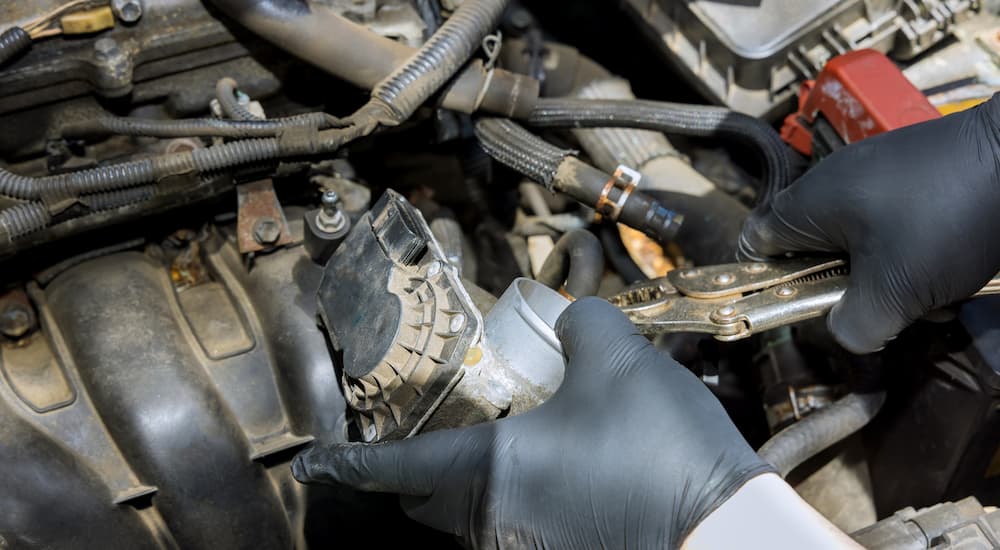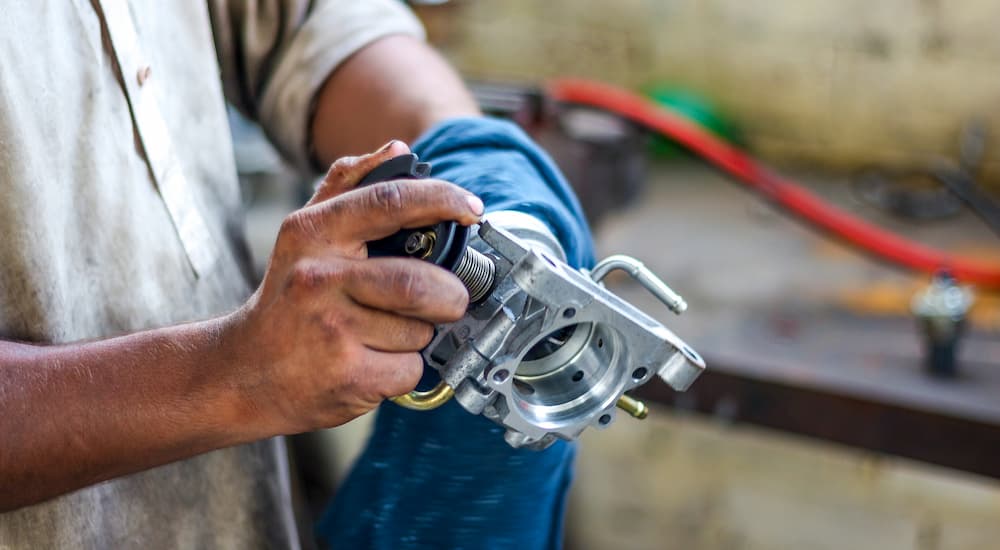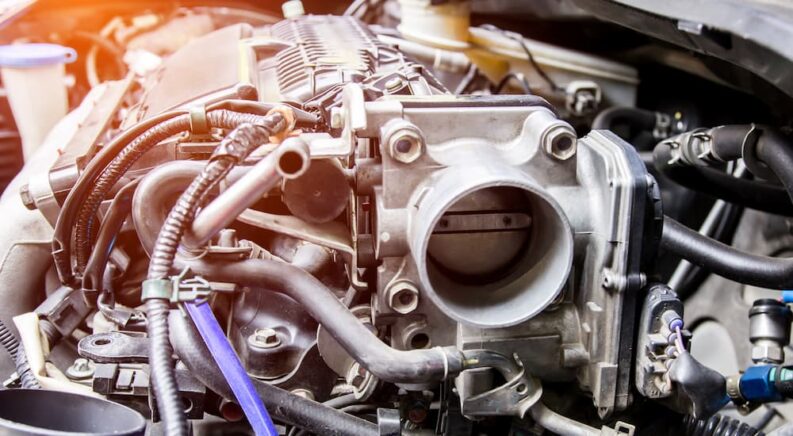A vehicle’s air intake system is a crucial part of the internal combustion process. To operate efficiently, vehicles require a precise mix of air and fuel. How is this balance achieved? It all comes down to a vehicle’s fuel injectors and throttle body. The role of a fuel injector is right there in the name–it’s responsible for dispensing fuel into the cylinder. But the importance of a throttle body might not be as readily apparent.
In the most basic terms, the throttle body is responsible for determining how much air enters the engine and plays an important role in achieving the correct air/fuel mixture. Located between the engine air filter and intake manifold, the throttle body is either directly connected to the gas pedal through a cable or electronically connected to a servo motor. Either way, when you step on the accelerator, a plate or valve within the throttle body opens up, allowing a precise amount of air to enter the engine and mix with the fuel. A faulty throttle body can cause no shortage of issues, from sluggish acceleration and poor fuel economy to rough idling, misfires, an illuminated Check Engine light, and even stalling.
Throttle body-related malfunctions aren’t super common, but they do happen, which is why it’s so important to be aware of some of the common signs and symptoms of a failing throttle body. Read on as we take you through some of the telltale signs of a failing throttle body, look at the underlying causes, and discuss a few relatively simple fixes.
Symptoms of Bad Throttle Body
How do you know if you have a bad throttle body? Even if you can find it under the hood, it might not be obvious just from looking at it. Here are some problems and bad behaviors that often indicate you have a problem with your throttle body.
Idling Issues
If your vehicle isn’t idling as smoothly as it once was, a compromised throttle body could well be the culprit. When the engine is running, but the vehicle isn’t moving, the throttle body should let just enough air through to keep things humming along at a low idle. If the throttle body isn’t in good shape, drivers might experience a rough idle after first starting the vehicle, or the engine completely stalling out when you step on the gas pedal. There can be lots of reasons for a rough idle or stalled engine, but the throttle body should be one of the first components you check if you notice any of these symptoms.
Check Engine Light
Back in the automotive Dark Ages, diagnosing a failing throttle body could mean hours spent poking around under the hood. Luckily, those days have largely passed for all but the most classic cars. In most modern vehicles, the throttle body is electronically controlled, which means it can easily send a signal to the vehicle’s Electronic Control Module (ECM) when something goes awry. This signal will trigger the Check Engine light and, when the vehicle is connected to a Diagnostic Trouble Code (DTC) reader, display a code like P2100, P2101, P2110, P2111, P2112, P2118 or P2135. A failing throttle body might also cause the vehicle to enter into what’s known as “limp home mode,” where the engine operates at reduced power to prevent any serious, long-term damage until the issue is addressed.

Poor Acceleration
A poor air/fuel mixture can lead to a host of performance issues, including sluggish acceleration. If stepping on the gas isn’t producing as robust of a response as you’re used to, it might be time to take a closer look at the throttle body. Again, this issue comes down to a lack of airflow in the throttle body, usually due to the buildup of grime or a compromised butterfly valve.
Bad Fuel Economy
When the throttle body isn’t working like it’s supposed to, it can easily lead to what’s known as a rich air/fuel mixture. This means that the air/fuel balance is straying a little too much towards the “fuel” side of the equation, with the throttle body not allowing in enough air for optimal combustion. The unburnt fuel is expelled through the exhaust, resulting in a distinct, gassy odor and impacting overall fuel economy. If you’ve noticed a lower average MPG and can easily smell gas when your vehicle is idling, it could be due to a malfunctioning throttle body.
Misfiring
A misfire occurs when one of the engine’s cylinders doesn’t produce power. This is usually due to a lack of spark, but a faulty throttle body can also be to blame. When the air/fuel ratio is off, all sorts of weird things can occur under the hood, and a misfire is just one of them. That said, a misfire is typically tied to an issue with the fuel injectors or spark plugs, though there is one easy way to narrow down the issue. When a misfire occurs, it’ll usually trigger a DTC like P0301, P0302, P0303, and so on. The last number in these codes indicates in which cylinder the misfire is occurring. If the misfire is related to a spark plug or fuel injector, the code will be localized to one cylinder, but since the throttle body feeds air to every cylinder, it’ll trigger a P0300 DTC when compromised, which is a random multiple misfire across all cylinders.
Causes of a Bad Throttle Body
There are several different ways a throttle body can fail. These are some of the most common.
Dirty Throttle Body
Sometimes dirt and grime are merely an aesthetic issue, but when it comes to your vehicle’s throttle body, it can have a noticeable impact on performance. A throttle body works best when it’s being fed clean air that’s free from any dirt and dust, which is why it is placed downstream from the engine air filter in the vehicle’s air intake system. However, things can go sideways when contaminants find their way into an intake. As contaminants start to build up, they can restrict airflow, preventing the throttle body from feeding the correct amount of air into the engine. They can also cause the throttle body plate or valve to stick, making it difficult to operate the throttle smoothly.
This scenario speaks to the importance of regular air filter changes, which can prevent the sort of buildup that can have such an impact on performance. A dirty, worn-out, or damaged air filter is more prone to letting dirt and grime slip through the cracks, which is why it’s vital to follow the manufacturer’s recommendations and replace it every 20,000 to 30,000 miles.
However, the air filter isn’t usually the prime suspect when it comes to a gunked-up throttle body. Carbon buildup tends to play more of a role, as the gasses from the crankcase and exhaust condense on the throttle body. These gasses contain oil vapor and other carbon-rich contaminants, which can seep into the throttle body through the positive crankcase ventilation (PCV) valve, resulting in messy carbon buildup that can easily impact performance. Fortunately, this can usually be cured by thoroughly cleaning the throttle body, rather than replacing it.

Electrical Problems
While the introduction of electronically controlled throttle bodies has increased precision and made it easier to diagnose a problem when something goes wrong, it does have some downsides. If the electrical circuits become compromised due to corrosion, a malfunction, or an outright short, the throttle body might not behave as it should. This can lead to no shortage of problems as the vehicle’s ECM can’t properly communicate with the throttle body, leading to an air/fuel mixture that’s way out of whack. If you suspect that the issue is related to the vehicle’s electronic system, keep an eye out for any frayed wires or corroded electrical connections.
Worn Butterfly Valve
As mentioned previously, a throttle body relies on a simple butterfly valve to control the amount of air flowing into the engine. In some cases, this valve can become worn or damaged, which can dramatically affect performance. This isn’t very common, as the air filter typically prevents any larger debris that could harm the butterfly valve from making its way to the throttle body. More likely, the butterfly valve becomes compromised due to the buildup of dirt and grime. If you notice an unusual buzzing-clicking noise emanating from the throttle body when the vehicle is turned on, a worn, bent, or otherwise compromised butterfly valve could be responsible.
Next Steps
You should never drive a vehicle with a faulty throttle body as it can lead to unpredictable performance, long-term engine damage, or worse. In most cases, the next step will come down to two options: cleaning the throttle body, or outright replacement. Replacing the throttle body can easily cost upwards of $1,000 (though typically more in the $500 to $800 range), so before dropping that kind of cash, let’s explore the cleaning route.
Cleaning the throttle body won’t always do the trick, but it can be effective when it comes to addressing symptoms like rough idling or stalling, which are typically related to carbon buildup. Start by disconnecting the negative battery terminal, removing the air intake hose from the throttle body, and disconnecting any electrical connectors between the throttle position sensor and the throttle body. Next, remove the throttle body from the intake manifold and get to cleaning. Your local auto parts store should carry a dedicated throttle body and air intake cleaner, which typically retails for under $10. Spray this cleaner throughout the throttle body, making sure not to skimp on the throttle plate itself.
Once all that gunk is loosened up, use a plastic brush to scrub it away, and repeat the process until everything is nice and clean. When you’re done, simply reassemble the throttle body, reattach it to the intake manifold, reconnect the air intake hose and throttle position sensor, and connect the negative battery terminal. Before you hit the road, you’ll have to perform a throttle body reset. This procedure varies by make and model and usually involves some combination of starting and stopping the car, but it’s important to look up the recommended steps for your specific vehicle. If your throttle body is past the point of no return due to a damaged throttle plate, shaft, mechanical linkage, electronic throttle actuator, sensor, or electrical connector, replacement might be in order. Fortunately, since you’ve already removed and reinstalled the throttle to clean it, you already know how to replace it with a new one and can save the cost of having a shop do it for you.
In a perfect world, you might get through your vehicle’s entire service life without ever once stopping to think about the throttle body. The part will typically last for as long as a vehicle is on the road. Regular inspections and cleanings aren’t even typically mentioned in a vehicle’s recommended maintenance schedule. That said, things do happen, but arming yourself with a little knowledge can help to prevent the worst outcomes. If you’ve noticed any of the symptoms listed above, including poor fuel economy and acceleration, a rough idle, or a Check Engine light, don’t discount a throttle body issue. It’s far from being the most common cause of these automotive issues, but vehicles are nothing if not unpredictable. Your car, truck, or SUV isn’t going to get too far without a well-functioning throttle body, but after reading this article, you should be able to head off any issues before they can balloon into an expensive repair job.

